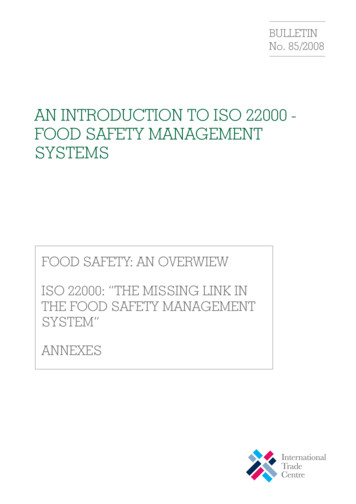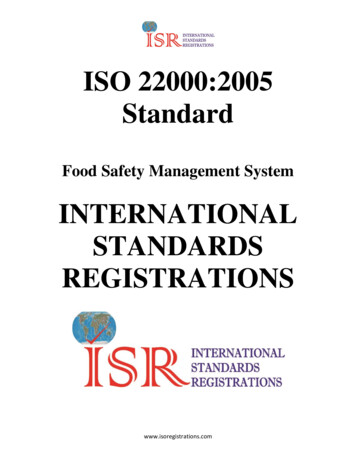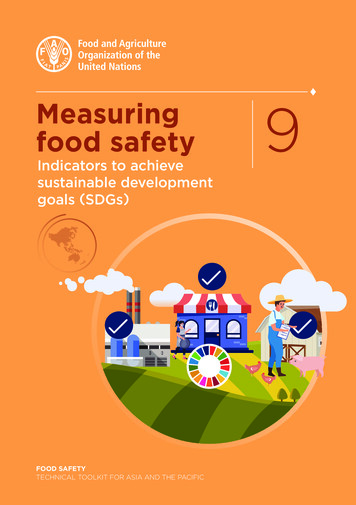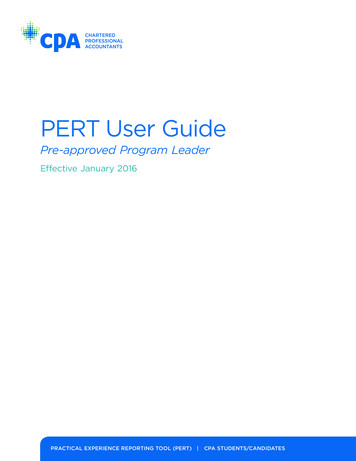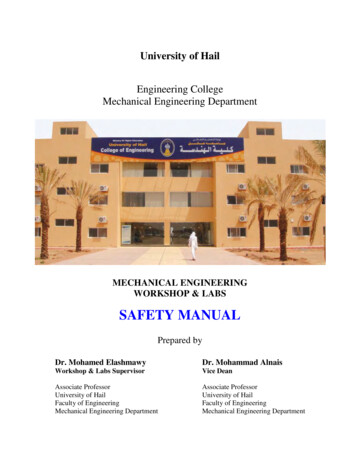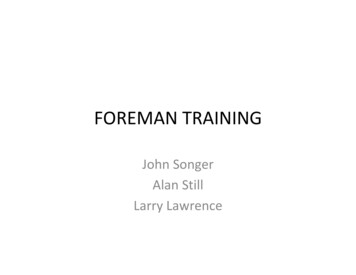
Transcription
Training ManualFood Safety Supervisor CourseAdvance (Level 2) Manufacturing
PREFACETraining of food handlers is a pre-requisite for ensuring food safety and the same isalso mandated in the FSS Act, 2006. Food Safety and Standards Authority of India(FSSAI) has set up Food Safety Training & Certification (FoSTaC) ecosystem toensure widespread and effective delivery of training to food businesses across thevalue chain. This ecosystem will train and certify the Food Safety Supervisor fromeach Food Establishment as it is envisaged to make this a regulatory requirement.The manual is designed to train the personnel that can be designated as Food SafetySupervisors in the manufacturing sector. This manual details the requirements onfood safety & hygienic practices to be followed by Food Business Operators engagedin the manufacturing sector. It is based on the Schedule 4 requirements of FSS(Licensing & Regulation of Food Businesses) Regulation, 2011 along with theindustry best practices. It has been designed according to the flow of operation in themanufacturing industry for ease of understanding of the Food Safety Supervisors.This one-in-all manual is supplemented by a Tutor Guide along with the visuals,specific to the food industry for facilitating the trainers.It is hoped that this manual will serve a wider purpose of training the Food SafetySupervisors and will also be useful to the food handlers in implementing the hygienerequirements in the food production premises.Pawan AgarwalChief Executive OfficerFood Safety & Standards Authority of India
ACKNOWLEDGMENTDr Indrani GhoseStrategic Advisor- Food Safety and Quality, CII-FACEDr Prabodh HaldeHead Technical Regulatory, Marico Ltd.Subhaprada NishtalaDirector, Food AdroitMr Sanjay IndaniHead – Food Safety, Safe Foodz SolutionsDr P Vijay KumarAsst. Professor, School of Agriculture, IGNOUMs Pritha TripathiScientist I, FSSAI
CONTENTSWELCOME TO THE MANUALLEARNING OUTCOMEWHAT THE LAW SAYSDEFINITIONSPART I– INTRODUCTION TO FOOD SAFETY1.1 Food safety & food safety hazards1.2 Food spoilage1.3 Activity 1PART II – LOCATION, LAYOUT & FACILITIES2.1 Location & surroundings2.2 Layout & design of food establishment premisesa) Outside the premisesb) Inside the premises2.3 Equipment & containers2.4 Facilitiesa) Water Supplyb) Drainage & Waste disposalc) Personnel facilities and toiletsd) Air quality and ventilatione) Lighting2.5 Activity 2PART III – CLEANING & SANITATION; MAINTENANCE OF ESTABLISHMENT3.1 Cleaning & Sanitation of Equipment and Premises3.2 Preventive & Corrective Maintenance3.3 Activity 3PART IV – PEST CONTROL4.1 Pest Control4.2 Monitoring & Detection4.3 Major Pests4.4 Activity 4
PART V – PERSONAL HYGIENE5.1 Health status5.2 Behavioural & personal cleanliness5.3 Visitors5.4 Activity 5PART VI FOOD OPERATION AND CONTROLS6.1 Procurement of raw materials6.2 Storage of raw material6.3 Production: Pre-processing, Production6.4 Product Packaging6.5 Approved Additives6.6 Activity 6PART VII- FOOD TRANSPORTATION, STORAGE & DISTRIBUTIONPART VIII MANAGEMENT AND SUPERVISIONPART IX FOOD TESTING9.1 Sampling9.2 Quality Testing Parameters9.3 Safety Testing ParametersPART X TRAININGPART XI AUDIT, DOCUMENT AND RECORDSPART XII PRODUCT INFORMATION &CONSUMER AWARENESS12.1 Product LabellingPART XIII Food Safety Management System Plan13.1 Introduction to FSMS13.2 FSMS Plan13.3 ActivityAnnexure Sample Inspection Checklist01: General Category02: Confectionary Products
03: Egg & Egg Products04: Ready to Eat Savouries05: Fruit & Veg ProcessingTUTOR GUIDEDisclaimer: The content of this handbook/ manual is only for training and capacitybuilding purpose, and is not intended to substitute applicable law, which may be referredto separately.INTENTIONALLY LEFT BLANK
Welcome to the manual –The manual is designed for medium to large scale food manufacturers, processors & packers.This manual explains General Requirements on Hygienic and Sanitary Practices to be followed byall Food Business Operators engaged in Food service establishments, as per Food Safety &Standard Act, 2006.This manual presents bare minimum requirements of Food Safety and Hygiene to be followed byFood Business Operators along with Industry best practices.Learning Outcome –The objective of this manual is to train the personnel that can be designated as Food SafetySupervisors in the Food Manufacturing units, about food safety and hygiene requirements whichare to be followed in their businesses. The Food Safety Supervisors (FSS) may interpret theserequirements according to the size and type of their establishment.The desired outcome of this manual is better understanding of food safety and hygienerequirements and high standards of food safety in the food industry.What the law says –The establishment in which food is handled, processed & packed, by the food business operatorand the persons handling them should conform to the sanitary and hygienic requirement, foodsafety measures and other standards as specified below. It shall also be deemed to be theresponsibility of the food business operator to ensure adherence to necessary requirements.In addition to the requirements specified below, the food business operator shall identify steps inthe activities of Food businesses, which are critical to ensure food safety, and ensure that safetyprocedures are identified, implemented, Maintained and reviewed periodicallyIn India, the mandatory sanitary & hygiene requirements for food business operators are –“Part II of Schedule 4”of Food Safety and Standards (Licensing & Registration of Food Businesses)Regulations, 2011 regulations.html) under FoodSafety & Standard Act, 2006 -safety-andstandards-act.html)
Definitions –“Act” means the Food Safety and Standards Act, 2006 (Act 34 of 2006)“Rules” means the Food Safety and Standards Rules, 2011.“Adulterant” means any material which is or could be employed for making the food unsafe orsub-standard or misbranded or containing extraneous matter.“Consumer” means persons and families purchasing and receiving food in order to meet theirpersonal needs.“Contaminant” means any substance, whether or not added to food, but which is present in suchfood as a result of the production (including operations carried out in crop husbandry, animalhusbandry or veterinary medicine), manufacture, processing, preparation, treatment, packing,packaging, transport or holding of such food or as a result of environmental contamination anddoes not include insect fragments, rodent hairs and other extraneous matter;“Food” means any substance, whether processed, partially processed or unprocessed, which isintended for human consumption and includes primary food to the extent defined in clause (zk)genetically modified or engineered food or food containing such ingredients, infant food,packaged drinking water, alcoholic drink, chewing gum, and any substance, including water usedinto the food during its manufacture, preparation or treatment but does not include any animalfeed, live animals unless they are prepared or processed for placing on the market for humanconsumption, plants, prior to harvesting, drugs and medicinal products, cosmetics, narcotic orpsychotropic substances :“Food Authority” means the Food Safety and Standards Authority of India established undersection 4;“Food business” means any undertaking, whether for profit or not and whether public or private,carrying out any of the activities related to any stage of manufacture, processing, packaging,storage, transportation, distribution of food, import and includes food services, catering services,sale of food or food ingredients;“Food business operator” in relation to food business means a person by whom the business iscarried on or owned and is responsible for ensuring the compliance of this Act, rules andregulations made there under“Hazard” means a biological, chemical or physical agent in, or condition of, food with the potentialto cause an adverse health effect;“Food safety” means assurance that food is acceptable for human consumption according to itsintended use;
“Food safety audit” means a systematic and functionally independent examination of food safetymeasures adopted by manufacturing units to determine whether such measures and relatedresults meet with objectives of food safety and the claims made in that behalf;“Food Safety Management System (FSMS)” means the adoption Good Manufacturing Practices,Good Hygienic Practices, Hazard Analysis and Critical Control Point and such other practices asmay be specified by regulation, for the food business;“Food Business Operator” in relation to food business means a person by whom the business iscarried on or owned and is responsible for ensuring the compliance of the Act, rules andregulations made there under
PART IINTRODUCTIONTOFOOD SAFETY1.1 Food Safety & Food SafetyHazards1.2 Food Spoilage1.3 Activity 1
1.1 FOOD SAFETY& FOOD SAFETY HAZARDSi.Food Safety means assurance that food is acceptable for human consumption accordingto its intended use.ii.Food Safety Management System means the adoption of Good ManufacturingPractices, Good Hygienic Practices, Hazard Analysis and Critical Control Point and suchother practices as may be specified by regulation, for the food business.iii.Food Safety Hazard means biological, chemical or physical agent in food, or conditionof food, with the potential to cause an adverse health effect. There are majorly four typesof hazards -PhysicalChemicalFoodHazardsBiologicalAllergensa. Physical HazardsAny foreign object (inanimate) found in the food or a naturally occurring object (metal, hardplastic), that poses a hazard is called a ‘Physical Contamination or Hazard’.Common Physical Hazards include:-GlassChipped pieces from equipmentMetal shavings from equipment’s, cans, foils etc.Stapler pinsBladesPlastic or chipped pieces of disposablesLint and threadsBand- aidsHairFinger nailsJewellery pieces
b. Chemical HazardsNaturally occurring and process induced chemical substances that can cause a food borne illnessare called a ‘Chemical Contaminant or Hazard’.Natural Chemical Contaminants include:-Biological toxinsMycotoxins (aflatoxin, ochratoxin etc.)Process Induced Chemical Contaminants include:- Toxic metals in the processing set up or supply chain- Pesticides, Colorants- Cleansing products and sanitizers- Equipment lubricants- Chemical Food Additives, Preservatives- Packaging materials-migration of residues from packaging material to oil.- Adulteration with other oils or mineral oilc. Biological HazardsBiological hazards are organisms, or substances produced by organisms, that pose a threat tohuman health. They are a major concern in food processing because they cause most food borneillness outbreaks.Major biological hazards include –- Bacteria ex: Salmonella spp., Enterohaemorrhagic Escherichia coli, Listeria monocytogenes,Staphlococcus aureus, Clostridium botulinum,- Yeast &Mold ex: Candida, Aspergillus sp., HelicosporiumBiological Hazards causes 1. Food Borne Infections – This result when a person consumes food containing pathogens;which grow in the human intestine and cause discomfort or disease. Typical symptoms of a‘food borne Infections’ do not appear immediately.2. Food Borne Intoxications - This result when a person consumes food containing toxins init; that cause discomfort or disease. Typical symptoms of a ‘food borne Intoxication’ appearquickly. Food Borne toxin are mediated infections, that result when a person consumesfood containing toxins produced by the pathogens in it; which grow in the human intestineand produce toxins that cause discomfort or disease.
Conditions favouring growth of MicroorganismsFAT ureDefinitionFood borne Microorganisms draw nutrients from Potentially hazardousfoodsFood borne Microorganisms grow well between the pH range of most foodsMicroorganisms grow well between the temperature range of 5⁰C – 60⁰C,most commonly known as the ‘Danger Zone’Microorganisms need sufficient time to grow; when exposed to the ‘DangerZone’Microorganisms require oxygen in free or combined state; to favor theirgrowthMicroorganisms require moisture to grow and is measured in the form of‘Water Activity (Aw)’d. Allergens (Informative purpose)An allergen is normally, any harmless substance that causes an immediate allergic reaction in asusceptible person. Food allergens are almost always proteins although other food constituents,such as certain additives, are known to have allergenic (allergy-causing) properties.Food allergy is a potentially serious immune response to eating or otherwise coming intocontact with certain foods or food additives.A food allergy occurs when the immune system:- Identifies a particular food protein as dangerous and creates antibodies against it- The next time the individual eats that food, immune system tries to protect the bodyagainst the danger by releasing massive amount of chemicals including Histamine- Histamine is a powerful chemical that can cause a reaction in the respiratory system,gastrointestinal tract, skin or cardiovascular system.- In the most extreme cases, food allergies can be fatal. Although any food can provoke animmune response in allergic individuals, a few foods are responsible for the majority offood allergies.The following foods and ingredients are known to cause hypersensitivity and shall always bedeclared:1. Cereals containing gluten; i.e., wheat, rye, barley, oats, spelt or their hybridized strains andproducts of these;2. Crustaceans and products of these;3. Eggs and egg products;4. Fish and fish products;5. Peanuts, soybeans and products of these;6. Milk and milk products (lactose included);
7. Tree nuts and nut products; and8. Sulphite in concentrations of 10 mg/kg or /CODEX.htmlFig 1.1 – Food AllergensHandling Allergens1. Raw Material –a. Review the labels of incoming raw materials for the appropriate allergen information orany changes.b. Tag each case/pallet/bag, etc. as appropriate of raw materials to ensure the allergen isclearly called out as the materials are stored and used in your facility.c. Handle appropriately any damaged containers of allergens to minimize crosscontamination at receipt.2. Store –a. Store allergenic ingredients or products separately to prevent minimize crosscontamination.b. Using clean and closed containers.
c. Designating separate storage areas for allergenic and non-allergenic ingredients and/orproducts. When segregated storage is not possible, use other methods such as not storingallergens over non-allergens, storing like allergens (peanuts and peanut butter) together,etc.d. Using and documenting clean up procedures for spills or damaged containers of allergens.e. Using dedicated pallets and bins.3. During production –a. Ensure the traffic patterns of raw materials, packaging supplies, and employees are limitedduring the production of allergen containing products and do not lead to cross-contact.b. If possible, have dedicated processing equipment and containers to prevent allergen crosscontact.c. Declare allergens on labels, for all product, including rework, and intermediate products.4. Sanitation –a. Have standardized procedures for sanitation operations (SSOP's) and ensure they arefollowed.b. Use appropriate cleaning methods (vacuum, soap and water wash, appropriate chemicals).c. Ensure adequate lighting in the proper locations (including flashlights to check insideequipment)d. Specify employee practices - hand washing at appropriate times (for example afterhandling a product that contains allergens, such as peanuts); proper hand washingprocedures; clean clothing/aprons.
1.2 FOOD SPOILAGEFood spoilage means that the original nutritional value, texture, flavour of the food aredamaged, the food become harmful to people and unsuitable to eat.Major reasons for food spoilage are –Fig 1.2 Food Spoilage Major Reasons1.2.3.Foreign matter: Human hair, stapler, metal particles, fabric, plastic, alkali etc. are big threatsto food safety and can cause food spoilage. Anything that is not considered as food or foodsubstance is considered as foreign matter.Lack of proper drainage: Improper drainage leads to clogged drains and accumulation ofwaste water in the processing area which attracts pests and microorganisms and can lead tofood contamination.Non- food grade equipment: Use of equipment’s that are made of non-food grade materialcan lead to food contamination. It is therefore important to use food grade equipment’s andvessels in the processing unit.
4.5.6.7.8.9.10.11.12.13.14.15.16.17.18.Improper handling: Unclean hands, wrong selection of equipment and packing in unsuitablematerial could result in food safety issues.Improper processing: Deviating from the Standard Operating Protocols (SOP’s) duringproduction can lead to major changes in the end product. Correct temperature, Correct timeand understanding the process steps is essential to ensure food safety and quality.Residues of chemicals: Chemicals come into contact with food as crop contaminants thenlater in the process of sanitizing voluntarily by our process. The next involuntary entry ofchemicals into food can be through residues of equipment or utensil sanitation operations.The presence of these residues can have adverse consequences on the consumer health. It istherefore essential to restrain the entry of chemical residues in the food production process.Non-standard sanitation: Sanitation must be based on strict guidelines of either historicaldata or validation. If chemicals are used in less or more quantity or in an unverified process ormethod, sanitation will fail to achieve proper results giving way for food to become unsafe.Improper raw materials: Raw material selection must be based on strict scientific referenceand frequent sampling. The raw materials should always be sourced from certified andapproved vendors.Additive: Additives of any nature like essence, flavors etc. can spoil food if not used in theright quantity. Unauthorized additive also must not be used.Water: Water is involved in food process in various stages from washing to soaking theninvolved in either directly food production as an ingredient or in some in-direct manner assteam. It is also important for washing and sanitation operations. Potable water shouldconform to the specifications of IS 10500:2012.Improper storage: Storage must not only be done by FIFO (First In First Out) or FEFO (FirstExpiry First Out) method but also properly segregated and with required ventilation. Rightcombination of duration, temperature ventilation and segregation defines a good storage.Any deviation in one of these could result in food becoming unsafe.Illness/Injury to staff: Food safety is very much dependent on the food handler’s personalbehavior and health status. A person with cough, cold, open wound, itching and any illnesswhich is of an irritable nature tends to make him handle things without washing his handsafter touching the body. The most common danger to food safety is from cough and cold andopen wounds for food handlers. Procedures should be in place and followed at all times forcases of illness and injury of the staff.Improper segregation: Appropriate segregation of RM, equipment, tools and final product isimportant to ensure consumer safety.Humidity: Humidity is a major cause that promotes microbial growth, and rancidity.Appropriate humidity levels should be identified and maintained as per the final product inthe processing unit.Temperature: Temperatures of processing, holding, storing, transporting, are all importantfactor in food being safe.Time: No raw material, or product should be held beyond designated shelf life.Non-food grade packing: Intermediate and final product should be packed only in food gradepacking material to ensure food safety.Pest: Care must be taken to plant pest control devices and other forms of controls to ensurethat they are highly restricted from either getting into product or contaminating productresulting in food safety issues.
19. Body fluids of rodents/pests: Contamination may be caused by body fluids like urine, fecalmatter of rodents, reptiles, pests, nocturnal animals and birds present in the storage yard,marketing yard, transportation etc.20. Improper waste disposal: Waste is an outcome of process but often present very close to theprocess region. If it is not disposed in a hygienic manner it can breed pest and microorganisms which are a threat to food safety.1.3 ACTIVITY- 11. Food Hazards can be present in food when reduced to an acceptable level.True/False2. Equipment Lubricant isa. Physical Hazardc. Biological Hazardb Chemical Hazardd. Allergen3. Chemical Hazard can come froma. Toxic metals in the processing set up, packaging materials.b. Pesticides, Colorants, Food Additives, Preservativesc. Cleansing Products, Sanitizersd. Equipment lubricants, adulteration with oilse. All of the above.4. Food Borne . result when a person consumes food containingpathogens.a. Infectionb. Intoxication
PART IILOCATION,LAYOUT &FACILITIES2.1 Location & Surroundings2.2 Layout & Design of Food EstablishmentPremises2.3 Equipment & Containers2.4 Facilities2.5 Activity 2
2.1 LOCATION & SURROUNDINGSManufacturing / processing / packaging premises shall be located away from sources of pollutionlike open drains, garbage yards, industries that emit fumes or gases and dense vegetation.In order to avoid contamination from external sources such as odor, pests, dust etc., appropriatemeasures shall be taken to protect the processing area from environmental contamination.Processing area shall not have direct access to any residential area.Fig.2.1 Illustrative of plant surrounding
2.2 LAYOUT & DESIGN OF FOOD ESTABLISHMENT PREMISESa) Outside the food production premiseLayout & Design of the food production unit should be uni directional to prevent backward flowof materials during processing. This is required in order to prevent cross contamination.Fig.2.2 Premises with tarred and concrete to avoid dustFig.2.3 Plant entrance with hygiene stationFig.2.4 Clearly defined walkwaysFig.2.5 Vegetation growth near premisesFig.2.6 Stagnant water near the surroundings
b) Inside the food production premise1. Floors, ceilings and walls of the establishment must be made of impervious material.They should be smooth and easy to clean with no flaking paint or plaster and maintained in asound condition to minimize accumulation of dirt, condensation & growth of mouldsFig.2.7 Clean, durable, impervious to moistureFig.2.9 Fungal growth on the wallsFig.2.8 Cracks allow bacteria and moulds toaccumulate.Fig.2.10 Ceiling made of impervious material
2. The doors in the establishment shall be made of smooth and non-absorbent surfaces andthey shall be easy to clean and disinfectant. Doors can be fiited with automatic closingspring, strip or air curtain.Fig 2.11 PVC Strip curtainsFig.2.12 Automatic closing spring doorFig 2.13 Air curtain3. The floor shall have adequate and proper drainage with appropriate slope and theyshould be easy to clean and disinfect. The drainage shall flow in a direction opposite to thedirection of food preparation area to avoid contamination.Fig.2.14 Special stone flooring to avoid slippery and easycleaning with machines to improve hygieneFig.2.15 Epoxy and smooth flooring in operation, easy forcleaning and avoids dust and microbial contamination4. The drains should be covered to prevent insects and rodents from entering the processingarea.
Fig.2.16 Floors should be sloped to ensure easy drainageFig.2.17 Drains should be covered to prevent insects and rodentsFig 2.18 Floor with proper drainage
5. The windows, doors & all other openings to outside environment in the establishment shallbe well screened with wire-mesh or insect- proof screen to protect the premise from pests.The doors shall be fitted with automatic closing springs to keep them closed at all timesand also the mesh should be easy to remove & clean to avoid accumulation of dust & dirt.Fig.2.19 Netlons and mesh in window to avoid pest entryFig.2.20. Pavers blocking the premises
2.3 EQUIPMENT & CONTAINERSDuring preparation / handling / processing / storage of food products like flour, sugar, dairybased products, spices, bakery ingredients, dry fruits, cereals & grains, oilseed, refined oil, etc.certain equipment’s e.g. scoops, spoons, cooking vessels, containers, tanks, silos, hoppers,pipes, packaging machines, filters, etc. come into contact with food. All these food contactsurfaces shall be: made up of non-corrosive / rust free material smooth, free from any grooves easy to clean and maintain non-toxic and non-reactive of food grade qualityGenerally, food grade stainless steel or galvanized iron material is preferred as it complieswith the above requirements.Fig.2.21. Rust free/ non corrosive coating of equipment’s---All the equipment’s used during food preparation, handling &packaging (if any) shall bedesigned, located and fabricated to facilitate easy cleaning and shall be kept away fromimpure air and dust.Every utensil or container containing food products shall at all times be either providedwith a properly fitted cover/lid or with a clean gauze net or other material of texturesufficiently fine to protect the food completely from dust, dirt and flies and other insects.No utensil or container used for the manufacturing of food items shall be kept in any placein which such utensil or container be contaminated and thereby render the food noxious.All equipment shall be kept clean, repaired and maintained in sound condition all the time.All measuring instruments / equipment like temperature gauges, pressure gauges,weighing balances, etc. shall be calibrated periodically for correct measurement.
Fig.2.22 Equipments should be easy to cleanFig.2.23 Covered storage containers
2.4FACILITIESa) Water Supply: Water used in cleaning of equipment’s / containers / cooking vessels shallbe potable and shall not introduce any hazards or contaminate the food products. Cleanand safe water storage facilities shall be provided. Steam, if used for heating of any foodmaterial shall be generated from potable water. If non-potable water is used anywhere incleaning of containers / areas which are not in use for food processing / handling / storage,then the concerned pipeline shall be identified as such or differentiated from potablewater.Fig.2.24 Colour coding of water pipes toavoid contaminationFig.2.25 Routine cleaning of water storage tanks
b) Drainage and waste disposal: Waste generated during processing like spillage of products,bleaching earth, spent wash, de-gummed oil, ash from boiler, etc. shall be collected regularly andsuch collected waste shall be stored in such a manner that it will not contaminate the food processand storage area inside / outside the environment of the premises. Waste generated in processingarea shall be collected in dustbins and dustbins shall be provided with lid, identified to a specificarea and cleaned regularly.Collected waste shall periodically be handed over to a local waste-collecting body or disposed of inan appropriate manner that will not cause any hazards.An Effluent treatment plant if required shall be set up as per the Environment Pollution ControlBoard.Fig.2.26 If required waste water disposal system/effluent treatment plantshall be put in place.Fig.2.27 Example of waste categorization with dedicated containersc) Personnel facilities and toilets: Personal facilities include hand washing and drying systemwith potable water supply, adequate and separate lavatories and changing facilities. Hand wash
facilities shall be provided with hot or cold running water with self-closing / or elbow operatedtap, soap solution, hand drying system / towel and disinfectant. Adequate number of separateclean toilets for males and females, refreshment rooms and changing rooms shall be provided atsuitable locations and these shall not have direct access to the process / storage area.To generate awareness in food handlers, display boards for ‘Do and Don’t’, personal hygiene,personal behaviour and good manufacturing practices shall be put up at prominent places withpictorial information and instructions in an understandable language or the local language.Hand wash stationsLocker roomFig.2.28 Hand-wash stationsFig.2.29 Locker roomFig.2.30 Appropriate signages in the factoryd) Air quality and ventilation system shall be designed and constructed so that air does notflowfrom contaminated areas to clean areas. Ventilation is especially important at workstationsdevoted to raw-material handling, processing, storage, etc.
Fig.2.31Proper Ventilation Systems
e) Lighting :Adequate lighting facility shall be provided to enable the food handlers to operatein a hygienic manner. Lighting shall be protected / covered to prevent contamination dueto accidental breakages.Fig.2.32 Proper lighting facility in the work areaFig.2.33 Covered lights in the production areaFig 2.34. All lights in the process and packaging halls should be covered with shatter proof materialto prevent any accidental contamination of product from shattered glass of lights
2.5 ACTIVITY-21. The layout of the production facility should allow .Movement of food product.2. The walls of the production facility should bea) Devoid of cracksb) Imperviousc) Smoothd) All of the above3. Routine maintenance and repair of equipment’s and containers is important.True/False4. Water used for cleaning of equipment’s, containers and cooking vesselsshould be .
PART IIICLEANING ANDMAINTENANCEOF EQUIPMENT3.1 Cleaning & Sanitation of equipmentand premises3.2 Preventive & CorrectiveMaintenance3.3 Activity 3
3.1 Cleaning &
Training of food handlers is a pre-requisite for ensuring food safety and the same is also mandated in the FSS Act, 2006. Food Safety and Standards Authority of India (FSSAI) has set up Food Safety Training & Certification (Fo STaC) ecosystem to ensure widespread and effective delivery of tra

